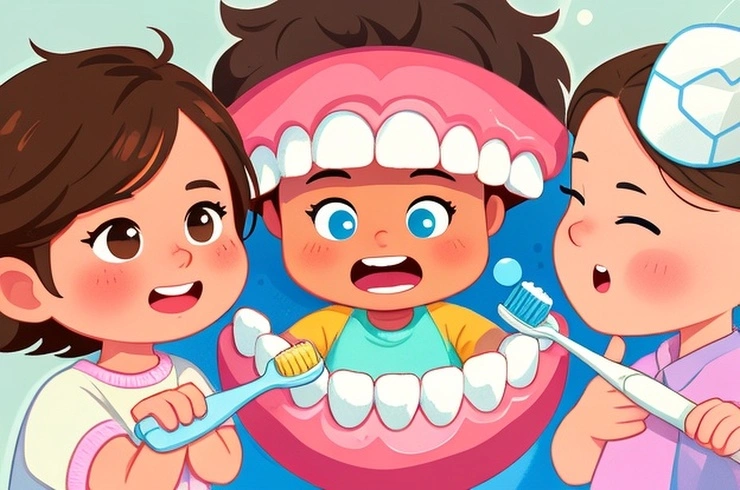
Your child's oral health journey begins with their baby teeth, also known as primary or deciduous teeth. There are 20 of these initial teeth, appearing in sets of four: central incisors, lateral incisors, cuspids (canine teeth), first molars, and second molars. Each set has two in the upper arch and two in the lower. These temporary teeth are crucial for holding space for future permanent teeth, aiding in clear speech, maintaining facial structure, and ensuring proper nutrition. They also set the foundation for healthy permanent teeth, as decay or infection in baby teeth can harm developing adult teeth.
As your child grows, these baby teeth are replaced by 32 permanent teeth. This adult set includes central incisors, lateral incisors, cuspids, first bicuspids (premolars), second bicuspids, first molars, second molars, and third molars (wisdom teeth). Each tooth type serves a specific purpose: incisors for biting and cutting, canine teeth for tearing, and premolars and molars for grinding and crushing food.
Every tooth, whether primary or permanent, shares a common structure: a visible crown protected by enamel, a neck connecting the crown to the root, and a root anchored in the jawbone.
The eruption of baby teeth typically starts around 6 months, with the two bottom central incisors often appearing first. By 2.5 to 3 years of age, most children will have all 20 primary teeth. As children reach age 4, their jaw and facial bones grow, creating natural spaces for the larger permanent teeth to emerge. From ages 6 to 12, children often have a mix of both primary and permanent teeth. Generally, about four teeth erupt for every six months of life, with lower teeth usually appearing before upper teeth, and girls tending to get teeth earlier than boys. Primary teeth are noticeably smaller and whiter than their permanent counterparts.
Early dental care is paramount. It's recommended that children see a dentist by age one or within six months of their first tooth emerging. The initial dental visit is typically short and aims to familiarize the child with the dentist in a positive environment. During this visit, the dentist will check for decay, examine the child's bite, and assess the health of gums, jaw, and oral tissues. They may also clean the teeth and discuss fluoride needs, oral hygiene practices, and developmental milestones with parents. Regular check-ups, often every six months, help build the child's comfort with dental visits and allow for early detection and treatment of potential issues.
A pediatric dentist offers specialized care, having completed at least two additional years of training focused on children's developing teeth, behavior, growth, and unique dental needs. While a general dentist can provide care, a pediatric dental office is specifically designed to make children feel at ease.
Dental X-rays are typically introduced around age 5 or 6, or earlier for children at higher risk of dental problems. X-rays are vital for monitoring the growth of permanent teeth, identifying bite issues, and assessing overall dental health.
Nutrition plays a crucial role in dental health. Excessive consumption of carbohydrates, sugars, and starches can lead to tooth decay. Encourage healthy food choices like fruits and vegetables, especially those high in water content like pears and celery. Cheeses, particularly aged varieties, stimulate saliva flow, which helps wash away food particles. Sticky, chewy foods should be limited, and if consumed, teeth should be brushed immediately afterward. Sugary treats are best served with meals rather than as snacks, as increased saliva during meal times helps cleanse the teeth. Limiting snacking frequency is more important than the quantity, allowing saliva time to clear food particles. Avoid sugary foods that linger, like lollipops, and never put a baby to bed with a bottle containing milk, formula, juice, or soda. Plain water is the best beverage choice, and a diet rich in calcium builds strong teeth.
Other essential dental hygiene tips include using xylitol-sweetened or sugar-free gum to reduce bacteria and boost saliva. Brushing twice daily with fluoride toothpaste is crucial for all ages, with a tiny amount for younger children. Fluoride strengthens enamel and can reverse early decay. Daily flossing removes particles between teeth and below the gum line. Fluoride mouthwash can be used for children over six. After giving children sugary medicines, always brush their teeth.
Easing a child's fear of the dentist is a shared responsibility between parents and dentists. Parents should introduce dental visits positively, using simple explanations and avoiding negative terms like "hurt" or "shot." Emphasize the dentist's role in maintaining healthy teeth. Dentists employ techniques such as friendly language, simple explanations, demonstrations, storytelling, and positive reinforcement to create a comforting environment. In some cases, sedation like nitrous oxide or an oral sedative may be used to help a child relax. A positive early experience with dental care can prevent lifelong dental anxiety.
Pro Tip
The content of the article is shared by netizens, please carefully identify it